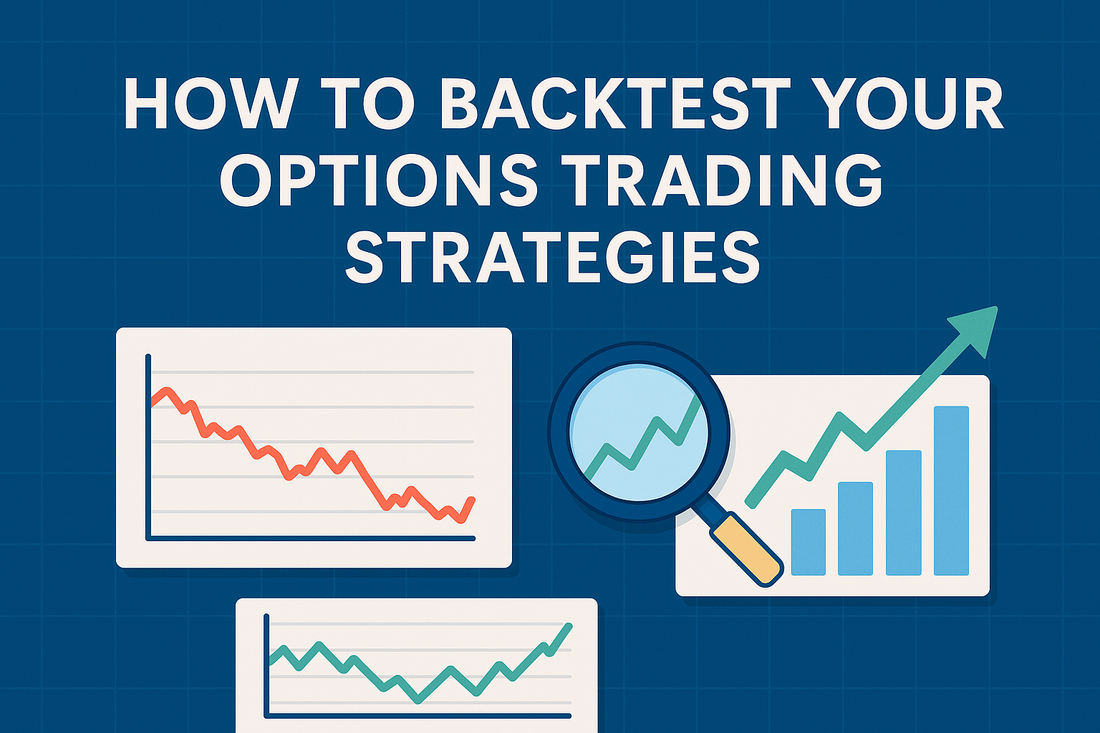
How to Backtest Your Options Trading Strategies
How to Backtest Your Options Trading Strategies
Backtesting is one of the most critical steps for any trader who is serious about becoming self-sufficient and achieving financial freedom through options trading. It’s the bridge between theory and practice, helping you validate your strategies using historical data before putting real money on the line. Whether you’re a beginner looking to avoid costly mistakes or an intermediate trader refining your edge, learning how to backtest effectively can set you apart from the crowd.
More importantly, backtesting is your gateway to independence. For aspiring traders who are tired of the 9-to-5 grind and dream of breaking free from the rat race, backtesting is a key pillar in building a consistent, scalable, and repeatable trading system. It's the blueprint for confidence and clarity in your trades—without relying on hype or guesswork.
In this guide, we’ll walk you through the step-by-step process of backtesting your options trading strategies, including the tools and methodologies you can use, how to analyze results, what pitfalls to avoid, and real-world case studies that show the impact of disciplined backtesting. We'll also include before-and-after performance graphs and strategic breakdowns to make the process more tangible.
What is Backtesting?
Backtesting is the process of simulating a trading strategy using historical market data to determine how it would have performed over time. In essence, it’s like building a time machine for your strategy. Instead of guessing or relying on market opinions, you let the data do the talking.
Why It Matters
- Eliminates guesswork: Know how your strategy would have fared across market cycles.
- Identifies strengths and weaknesses: Discover when and why a strategy thrives or fails.
- Provides confidence: With data-backed insights, you trade with conviction.
Backtesting is especially valuable for options traders because of the complexity involved: time decay, volatility shifts, multi-leg setups, and different expiration dates. All these factors make it harder to understand outcomes intuitively, so rigorous testing is essential.
Tools and Methodologies
Manual Backtesting
This old-school method involves tracking trades by hand or using spreadsheets. It's ideal for beginners looking to understand strategy logic and trade flow.
Steps:
- Choose your strategy and define entry/exit rules.
- Use historical options chains or price charts.
- Log each trade manually: entry, exit, premium, result.
- Calculate metrics like win rate and average return.

Excel-Based Backtesting
Excel offers more automation. With basic formulas, you can simulate trades faster and track multiple variables, such as:
- Strike prices
- Premiums collected
- Days to expiration
- Outcome (Win/Loss)
- Profit & Loss
Consider using conditional formatting, dropdown logic, and pivot tables for powerful insights.
Dedicated Platforms
|
Platform |
Best For |
Features |
|
ThinkOrSwim |
Beginners/Intermediate |
Paper trading, visual charts, ThinkScript |
|
OptionStack |
Retail Algo Traders |
Strategy builder, automation, performance |
|
QuantConnect |
Coders/Quant Traders |
C# or Python algorithms, historical options |
|
OptionOmega |
Options-focused Traders |
Drag-and-drop backtests, strategy metrics |

Programming Languages
For tech-savvy traders, Python and R offer ultimate flexibility. With Python libraries like Backtrader, QuantLib, or pandas, you can test thousands of trades across different market conditions and get granular with your data analysis.
Case Study: The Iron Condor Strategy
Scenario: A retail trader wants to generate consistent monthly income using an iron condor strategy on the SPY ETF. They believe that during periods of low volatility, SPY tends to stay within a tight range.
Strategy Setup:
- Sell 1 OTM call
- Buy 1 further OTM call
- Sell 1 OTM put
- Buy 1 further OTM put
- All legs are 30-45 DTE (days to expiration)
- Target premium collected: 1.5% of the width of the strikes
Backtest Period: Jan 2018 - Dec 2022
Entry Rule: Open new position every 30 days if IV Rank < 30
Exit Rule: Close at 50% max profit or 21 DTE, whichever comes first
Results:
- Win Rate: 74%
- Max Drawdown: -12%
- Average Monthly Return: 1.8%
- Sharpe Ratio: 1.25

Insights Gained:
- Strategy performs best in sideways or slow bull markets
- Drawdowns occur during volatility spikes (e.g., March 2020 COVID crash)
- IV rank filtering significantly reduced losses
Optimization Ideas:
- Add VIX filter for additional confirmation
- Avoid earnings season exposure if using on individual stocks
Strategy Breakdown: Covered Calls vs. Poor Man’s Covered Calls
Covered Call:
- Own 100 shares of stock
- Sell 1 OTM call monthly for income
Poor Man’s Covered Call (PMCC):
- Buy a long-dated deep ITM call (LEAPS)
- Sell short-term OTM call against it repeatedly
Backtest Comparison (on AAPL 2017–2022):
|
Metric |
Covered Call |
Poor Man’s CC |
|
Capital Required |
$14,000 |
$1,800 |
|
Average Annual Return |
9.8% |
15.2% |
|
Max Drawdown |
-19% |
-22% |
|
Trade Frequency |
Monthly |
Monthly |

Conclusion: PMCC offers better capital efficiency and comparable risk, ideal for small accounts.
Visual Walkthrough: Backtest Setup in Excel
We’ve added a screenshot-style breakdown of what an Excel backtest might look like for a simple credit spread.
Sheet Columns:
- Trade Entry Date
- Underlying Price
- Strike Prices (Short & Long)
- Premium Collected
- Expiry Date
- Outcome (Win/Loss)
- P&L

Color-coded cells can help quickly spot trends — for instance, red for losses and green for wins. Add a separate chart plotting the cumulative P&L to visualize equity growth.
Visual Case Study: Performance Chart Comparison
We include a side-by-side image of the equity curve before vs. after strategy optimization:

Before: Lots of peaks and troughs with inconsistent results.
After: Smooth upward trajectory with controlled drawdowns.
This helps traders visually grasp the power of consistent application and rule-based optimization.
Analyzing Results
After running a backtest, the next step is to evaluate the findings with a critical eye. Here are the key metrics to assess:
- Win Rate – What percentage of trades were profitable?
- Profit Factor – Ratio of gross profit to gross loss. Above 1.5 is generally solid.
- Max Drawdown – Largest peak-to-trough loss. Indicates risk of ruin.
- Average Trade Return – How much profit/loss do you get per trade?
- Sharpe Ratio – Risk-adjusted return. Higher is better.
- Expectancy – The mathematical expectation of each trade based on past performance.

Final Thoughts: Trade with Confidence, Not Hope
Backtesting transforms hope into high-probability outcomes. It removes emotion, anchors you to reality, and helps you shape a professional-grade trading system built on data, not dreams.
It’s not about finding a "perfect" strategy. It’s about finding what works for you—your capital, your risk tolerance, and your lifestyle.
At www.optionstranglers.com.sg, we guide traders through every step of that journey—from creating their first backtest to mastering advanced strategies and joining a community of like-minded traders who are committed to long-term freedom and success.
Want More Real Case Studies and Guided Mentorship?
At www.optionstranglers.com.sg we offer:
- In-depth live 1-1 sessions / group classes
- Trade examples and breakdowns
- Community mentorship and support
👉 Ready to upgrade your strategy and trade like a pro? Visit www.optionstranglers.com.sg and start your journey to financial freedom today.
Your future is an option. Choose wisely.
Disclaimer: Options involve risk and are not suitable for all investors. Always consult with a financial advisor before investing.
